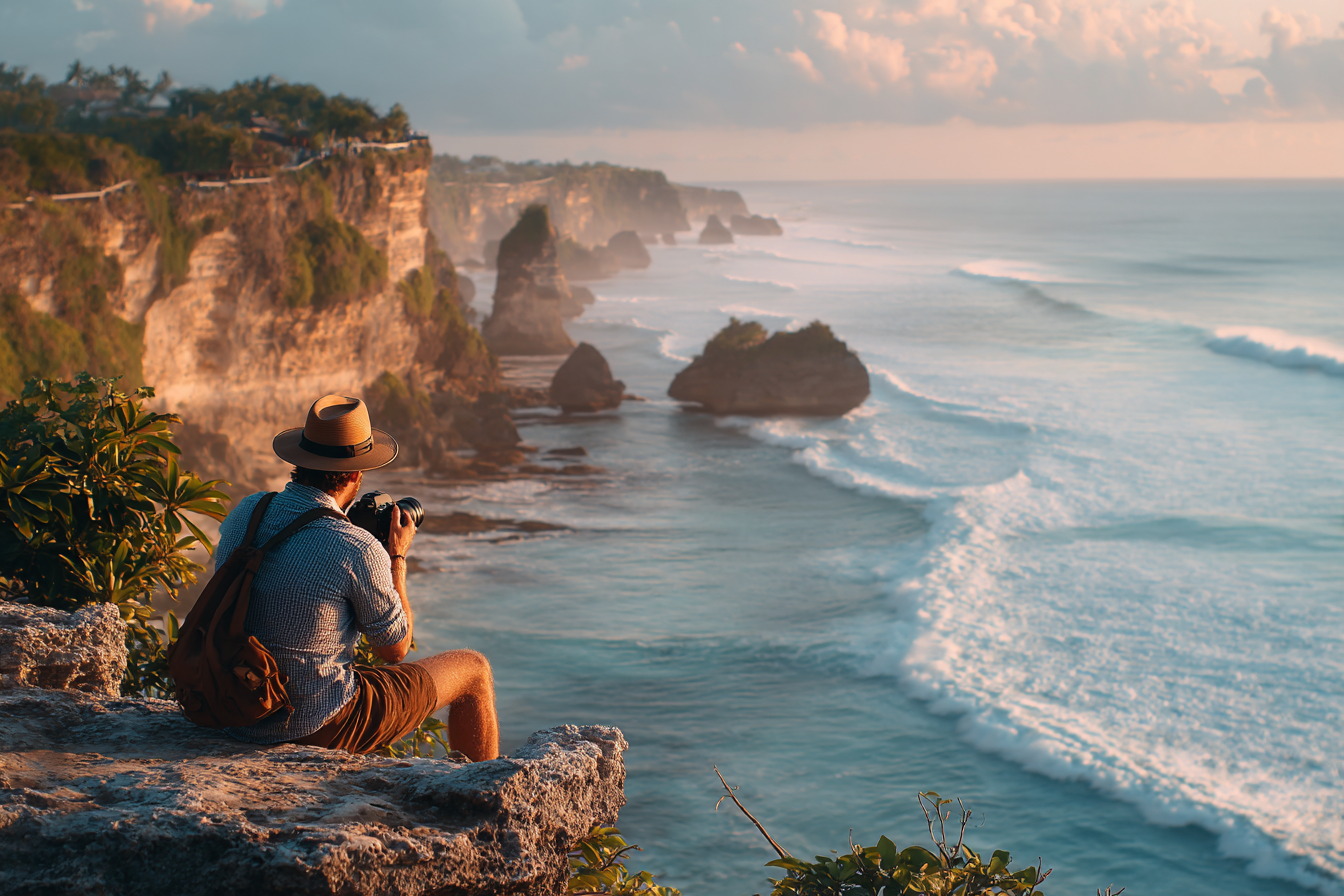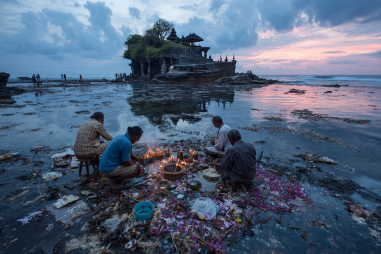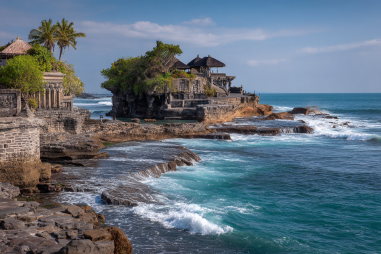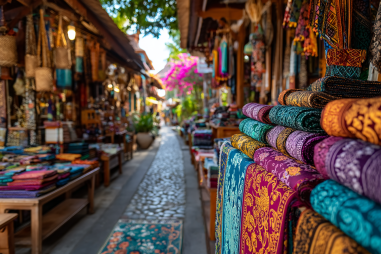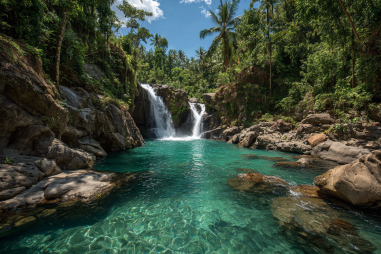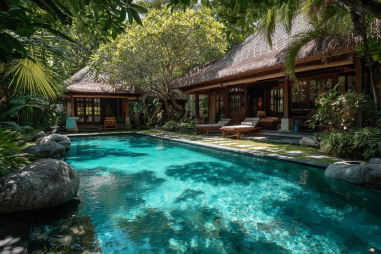Uluwatu, perched on the southern tip of Bali, is a paradise for photographers and travelers alike. Renowned for its dramatic cliffs, pristine beaches, and culturally rich sites, this region offers a kaleidoscope of stunning backdrops that are sure to inspire your camera lens. Whether you’re a professional photographer or an avid Instagrammer, Uluwatu’s diverse scenery provides countless opportunities for capturing breathtaking images. In this article, we’ll explore the best photography spots around Uluwatu and share some handy tips to make your photography journey even more rewarding.
Scenic Viewpoints and Overlooks
One of Uluwatu’s greatest charms lies in its elevated vantage points offering panoramic views of the Indian Ocean. These scenic overlooks provide stunning compositions, especially during sunrise and sunset when the sky bursts into vibrant colors.
Uluwatu Cliff: The dramatic cliffs themselves are a must-visit. From various points along the cliffline, you can capture sweeping vistas where waves crash against the rocks far below. The contrast between the deep blue ocean and the rugged cliff edges creates powerful imagery.
Single Fin Bar Viewpoint: Nestled atop a cliff, this spot gained fame among surfers and travelers alike. From here, you can photograph surfers riding the iconic waves, framed by the endless horizon. The golden hour light here is especially dreamy, casting warm hues over the sea and cliffs.
El Kabron Cliff Club: Offering a stylish rooftop vantage point, this restaurant and bar provides elevated views perfect for golden hour and night photography. Capture the sun melting into the ocean with silhouettes of guests for added storytelling impact.
Temples and Cultural Sites
Uluwatu is home to some of Bali’s most iconic cultural landmarks, blending natural beauty with spiritual significance—ideal for evocative photography that tells a deeper story.
Pura Luhur Uluwatu Temple: Perched precariously on the edge of a cliff, this sea temple is one of Bali’s key artistic and spiritual treasures. Capture shots of the temple’s intricate architecture framed against expansive ocean views. The traditional Kecak dance performed here at sunset provides a dynamic subject filled with color, movement, and cultural depth.
Garuda Wisnu Kencana (GWK) Cultural Park: Though slightly inland, this massive cultural park features the magnificent statue of the Hindu god Vishnu riding the mythical bird Garuda. Photographers can experiment with various angles that highlight the statue’s scale against the sky, or explore the landscaped gardens for intricate details.
Beach and Ocean Shots
Uluwatu’s coastline boasts some of Bali’s most beautiful beaches, many of which are less crowded and offer unique beachscape opportunities.
Padang Padang Beach: Known for its white sands and turquoise waters, this beach allows both wide landscapes and intimate portraits. The pathway down through lush cliffs adds a dramatic entry frame.
Bingin Beach: A favorite among surfers, Bingin offers a more rustic vibe with reef breaks and striking cliffs. The ocean’s movement combined with the rocky foregrounds creates dynamic shots.
Suluban Beach (Blue Point): Famous for its hidden caves and unique entrance carved out by waves, Suluban Beach is perfect for moody, artistic compositions. Early morning visits here provide soft lighting and fewer crowds, allowing you to focus on textures and shadows.
Tips on Lighting and Timing
Mastering natural light is vital to capturing Uluwatu’s beauty. The best times for photography usually align with the golden hours—shortly after sunrise and before sunset—when soft, warm light enhances colors and adds depth to your images.
- Sunrise: Ideal for quiet, serene landscapes and cooler tones over cliffs and beaches.
- Sunset: The warm glow works beautifully on temples and ocean horizons, enhancing silhouettes and dramatic skies.
- Blue Hour: Post-sunset light offers a magical ambiance perfect for moody seascapes and lit cultural sites.
- Midday: Though often too harsh, midday light can be suitable for shooting textures of rock formations and detailed temple carvings in shaded areas.
Keep an eye on weather forecasts, as clouds and mist can add unpredictable drama or soften harsh shadows. Arriving early also gives you time to scout the best angles and catch those less crowded moments.
Equipment Recommendations
Your gear choice will depend on the style of photography you prefer, but here are some recommendations for getting the most out of your Uluwatu photography adventure:
- Camera: A DSLR or mirrorless camera will provide versatility and image quality. Compact cameras and smartphones can also capture excellent shots if you know your settings.
- Lenses: A wide-angle lens (10-24mm) is perfect for capturing vast landscapes and temple shots. A zoom lens (70-200mm) helps frame distant details or surf action. A 50mm prime lens is great for portraits and low-light situations.
- Tripod: Essential for steady shots during sunrise, sunset, and long exposures on beaches or temple interiors.
- Filters: A polarizing filter can reduce glare from water and enhance skies, while neutral density (ND) filters are excellent for long exposures to smooth out waves.
- Accessories: Extra batteries and memory cards, lens cleaning cloths, and a rain cover or waterproof bag to protect your gear from sudden showers or sea spray.
Responsible Photography Practices
Uluwatu’s charm lies not only in its scenery but also in its cultural and natural integrity. As photographers, it’s important to respect the environment and local customs to preserve the magic for everyone.
- Respect Sacred Sites: When photographing temples, dress modestly and follow guidelines. Always ask permission before photographing people, especially during religious ceremonies.
- Stay on Paths: Avoid trampling vegetation or disturbing natural formations, particularly on cliffs and beaches where ecosystems can be fragile.
- Avoid Drones in Restricted Areas: Many temples and protected zones prohibit drones, so always check local regulations.
- Leave No Trace: Carry out all trash and minimize your footprint to keep the area pristine.
Engaging responsibly not only enriches your experience but ensures that future visitors and photographers can enjoy these breathtaking scenes as well.
Your Uluwatu Photography Itinerary
To help you plan an efficient and rewarding photography trip, here’s a sample itinerary that covers the best spots across different times of the day:
- Early Morning: Start with sunrise shots at Uluwatu Cliff or Suluban Beach to capture tranquil light and fewer people.
- Midday: Head to Garuda Wisnu Kencana Cultural Park for sharp architectural details and shaded garden photography.
- Afternoon: Visit Padang Padang and Bingin Beaches to explore varied coastal landscapes and surfer action.
- Late Afternoon to Sunset: Conclude your day at Pura Luhur Uluwatu Temple for a magical combination of cultural shots and sunset panoramas, then stay for the Kecak fire dance performance to capture vibrant motion and emotion.
By following this route and keeping an eye on lighting conditions, you’ll come away with a portfolio showcasing the diverse beauty and spirit of Uluwatu.
Uluwatu is truly a treasure trove for anyone passionate about photography. From majestic cliffs and pristine beaches to sacred temples and vibrant local culture, each location invites you to create unforgettable images. With thoughtful planning, respect for the environment, and a keen eye for natural light, your journey to Uluwatu will be as rewarding behind the lens as it is in experiencing Bali’s enchanting southern coast.

